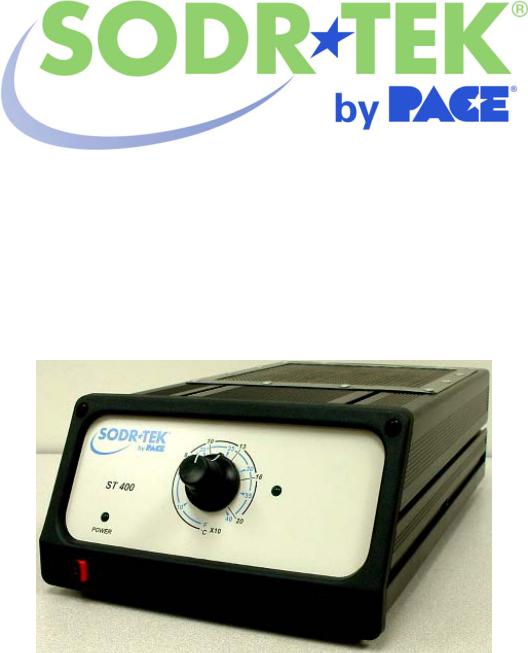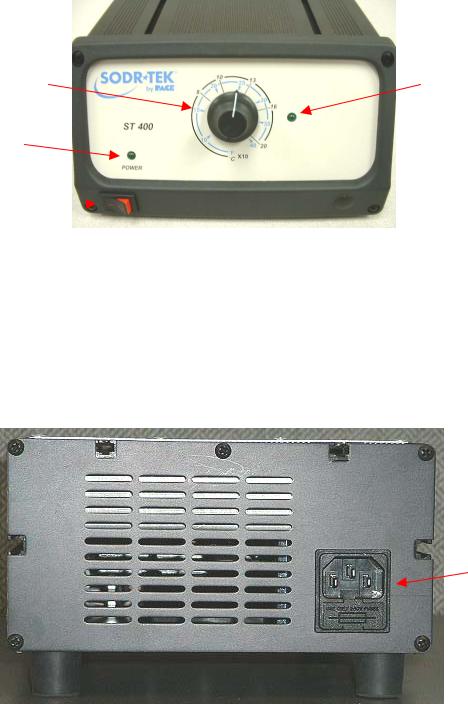PACE ST 400 Service Manual

Operation and Maintenance Manual for the SODRTEK® ST 400
Radiant Pre-Heating System
P/N 5050-0540
TITLE |
PAGE |
General Information ....................................................................................................... |
3 |
Introduction........................................................................................................... |
3 |
Specifications ....................................................................................................... |
3 |
Physical Parameters ............................................................................................ |
3 |
Parts Identification................................................................................................ |
4 |
Safety ............................................................................................................................. |
5 |
Safety Guidelines ................................................................................................. |
5 |
Preheating Basics .......................................................................................................... |
5 |
System Power Up .......................................................................................................... |
6 |
Operation........................................................................................................................ |
6 |
LED Operation...................................................................................................... |
6 |
Variable Temperature Control.............................................................................. |
7 |
Corrective Maintenance ................................................................................................. |
7 |
General Maintenance ........................................................................................... |
7 |
Heater Replacement ............................................................................................ |
7 |
Power Source...................................................................................................... |
12 |
Packing List................................................................................................................... |
12 |
Spare Parts ................................................................................................................... |
12 |
Service .......................................................................................................................... |
12 |
“SODRTEK by PACE” LIMITED WARRANTY STATEMENT....................................... |
13 |
Contact Information....................................................................................................... |
14 |
©2004 PACE Inc., Annapolis Junction, Maryland |
Page 2 of 14 |
All Rights Reserved |
|
General Information
Introduction
Thank you for purchasing the PACE SODRTEK® model ST 400 Radiant Pre-Heating System. This manual will provide you with the information necessary to properly set up, operate and maintain the ST 400. Please read this manual thoroughly before using the unit.
The ST 400 unit is available in either the 115 VAC or 230 VAC version. The 115 VAC version system bears the FCC Conformity Marking which assures the user that it conforms to all the requirements of FCC Emission Control Standard, Title 47, Subpart B, Class A. The 230 VAC version system bears the CE Conformity Marking which assures the user that it conforms to all the requirements of (EU) directive EMC 89/336/EEC & 73/23/EEC.
Specifications
ST 400 - Operates on 97-127 VAC, 60 Hz (115 VAC version) 405 Watts maximum at 120 VAC, 60 Hz
ST 400E - Operates on 197-264 VAC, 50 Hz (230 VAC version) 405 Watts maximum at 230 VAC, 50 Hz
Heater Type: Radiant, 400 Watt (200 W x 2), closed loop, thermo-couple control
Temperature: 100 ºF (37.78 ºC) – 400 ºF (204.44 ºC) Range
Physical Parameters
Dimensions: 7” (17.78 cm) W x 4.1” (10.41 cm) H x 12.5” (31.75 cm) D
Unit Weight: 4.9 pounds (2.2 kg)
©2004 PACE Inc., Annapolis Junction, Maryland |
Page 3 of 14 |
All Rights Reserved |
|

Parts Identification
Variable |
Temperature |
|
Temperature |
Indicator LED |
|
Control |
|
|
Power LED |
|
|
Power Switch |
|
Figure 1 |
|
||
|
|
|
AC Power
Receptacle/Fuse
Holder
Figure 2
©2004 PACE Inc., Annapolis Junction, Maryland |
Page 4 of 14 |
All Rights Reserved |
|
Safety
Safety Guidelines
The following are safety precautions that personnel must understand and follow when using or servicing this product.
1.POTENTIAL SHOCK HAZARD - Repair procedures on PACE products should be performed by Qualified Service Personnel only. Line voltage parts may be exposed when the equipment is disassembled. Service personnel must avoid contact with these parts when troubleshooting the product.
2.To prevent personnel injury, adhere to safety guidelines in accordance with OSHA and other applicable safety standards.
3.Always use PACE systems in a well ventilated area. A fume extraction system such as those available from PACE are highly recommended to help protect personnel from solder flux fumes.
4.Exercise proper precautions when using chemicals (e.g., solder paste). Refer to the Material Safety Data Sheet (MSDS) supplied with each chemical and adhere to all safety precautions recommended by the manufacturer.
5.Do not contact the Heater or its peripheral parts during operation.
6.Once turned off, let the unit cool completely before contacting.
7.After use, verify that the amber indicator lamp is off.
8.When using Fluxes, use fume extraction equipment or use in a well-ventilated area to minimize operator exposure to fumes.
Preheating Basics
Preheating of a printed circuit assembly is normally required in the repair process whenever any one or more of the following situations exist.
1.Epoxy glass substrate with 4 or more layers.
2.Substrate with large ground planes.
3.Substrate of ceramic, polyimide or other high heat dissipative material.
4.Printed circuit assembly with large metal heat sinks.
Preheating of assemblies such as those listed above will accomplish the following objectives.
1.Minimize thermal shock by elevating the assembly temperature to a level closer to solder melt temperature.
2.Minimize the heat cycle reflow time.
3.Overcome the heat dissipation characteristics of the assembly.
4.Minimize adjacent melts on densely populated assemblies.
©2004 PACE Inc., Annapolis Junction, Maryland |
Page 5 of 14 |
All Rights Reserved |
|
